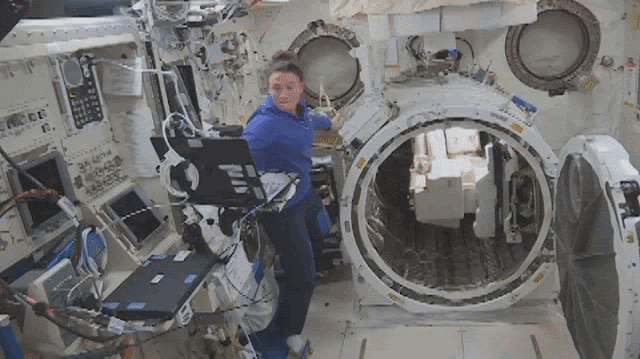ISS - Expedition 56 Mission patch.
Sept. 10, 2018
The Expedition 56 crew members aboard the International Space Station were busy last week preparing for the arrival of Japan’s H-II Transfer Vehicle (HTV-7). However, the Japan Aerospace Exploration Agency (JAXA) has since postponed the launch of HTV-7, previously scheduled for September 10th. Our space scientists also spent the week preparing to become space walkers in preparation for two spacewalks, scheduled for later in the month.
Image above: European Space Agency astronaut Alexander Gerst shared this image on his social media, saying, “Sweating for science. You can probably tell that Spacetex & Metabolic Space are some of my favorite experiments. In any case, they will help a lot of people on Earth to stay healthy." Image Credits: ESA/NASA.
Crew members studied new materials, conducted technology demonstrations for future long-duration space travel, and conducted an air quality test, among other scientific operations. Learn more below:
Crew reverse roles in investigation to increase proficiency
A tool that has helped guide sailors across oceans for centuries is now being tested aboard the station as a potential emergency navigation tool for guiding future spacecraft across the cosmos. The Sextant Navigation investigation tests use of a hand-held sextant aboard the space station.
Animation above: NASA astronaut Serena Auñón-Chancellor working within the JEM facility to remove the degraded JEM EF HDTV Camera Unit from the Exposed Facility Unit (EFU) Adapter. A new, replacement camera was subsequently installed on the EFU Adapter in preparation for the JEM Airlock depressurization and Monday’s installation of the HDTV unit. The HDTV-EF2 is a high-definition television camera system used for Earth observation from the station. Animation Credits: NASA.
Sextants have a small telescope-like optical sight to take precise angle measurements between pairs of stars from land or sea, enabling navigation without computer assistance.
Last week, the crew performed a session for the investigation. In this session, the operator and assistant roles were reversed in order to gain proficiency for both crew members. The crew collected the data and recorded the results for ground evaluation. This was reported to be the most productive session to date.
For more information about the investigation, click here: https://www.nasa.gov/mission_pages/station/research/news/Sextant_ISS
Crew completes testing in station’s airlock
With dust particles present in the space station atmosphere, Airway Monitoring studies the occurrence and indicators of airway inflammation in crew members, using ultra-sensitive gas analyzers to evaluate exhaled air. This helps to highlight any health impacts and to maintain crewmember well-being on future human spaceflight missions, especially longer-duration missions to the Moon and Mars for example, where crewmembers will have to be more self-sufficient in highlighting and avoiding such conditions. This kind of research may also benefit people on Earth who suffer from airway health conditions such as asthma.
Animation above: NASA astronaut Ricky Arnold replaced the EXPRESS Rack 5 lower payload valve following indications that a leak from the Moderate Temperature Loop (MTL) in the Japanese Experiment Module (JEM) had continued after the initial repairs of the main payload valve. The successful recovery of EXPRESS Rack 5 will allow installation of the Plant Habitat Science Carrier #2 and subsequent resumption of science in the facility. Animation Credits: NASA.
Last week, the crew completed a session of Airway Monitoring in the station’s US Airlock. After reviewing procedures, the crew performed the testing at both ambient and reduced (10.2psi) pressure in the airlock.
New fabrics tested aboard station
Crew members perform daily exercise aboard the station to avoid cardiovascular deconditioning, and to maintain bone density and muscle mass. Problems associated with this physical deconditioning will become increasingly prominent during future exploratory missions, which could also have a negative effect on quality of sleep, alertness and mental performance of the crew.
Last week, as a part of the SpaceTex-2 and Metabolic Space investigations, a crew member donned Thermolab equipment, a heartrate monitor and the SpaceTex material shirt, as well as Metabolic Space equipment, for an exercise session using the Cycle Ergometer with Vibration Isolation and Stabilization (CEVIS).
Space to Ground: Batteries Included: 09/07/2018
SpaceTex fabrics provide a higher rate of sweat evaporation and a corresponding higher evaporative heat loss compared to conventional cotton fabrics typically used by crew members aboard the station. Metabolic Space provides a technology demonstration for a measurement system worn by crew that supports cardio-pulmonary diagnosis during physical activities, while maintaining unrestricted mobility.
Other work was done on these investigations: BPC-1, Lighting Effects, BCAT-CS, ISS HAM, Rodent Research-7, Team Task Switching, EDR/EML, Neuromapping, HDTV-EF2, Atomization, Radi-N2, BEST and Food Acceptability.
Related links:
Expedition 56: https://www.nasa.gov/mission_pages/station/expeditions/expedition56/index.html
Sextant Navigation: https://www.nasa.gov/mission_pages/station/research/experiments/explorer/Investigation.html?#id=7646
Airway Monitoring: https://www.nasa.gov/mission_pages/station/research/experiments/explorer/Investigation.html?#id=1067
SpaceTex-2: https://www.nasa.gov/mission_pages/station/research/experiments/explorer/Investigation.html?#id=7571
Metabolic Space: https://www.nasa.gov/mission_pages/station/research/experiments/explorer/Investigation.html?#id=7574
CEVIS: https://www.nasa.gov/mission_pages/station/research/experiments/explorer/Facility.html?#id=821
BPC-1: https://www.nasa.gov/mission_pages/station/research/experiments/explorer/Investigation.html?#id=7729
Lighting Effects: https://www.nasa.gov/mission_pages/station/research/experiments/explorer/Investigation.html?#id=2013
BCAT-CS: https://www.nasa.gov/mission_pages/station/research/experiments/explorer/Investigation.html?#id=7668
ISS HAM: https://www.nasa.gov/mission_pages/station/research/experiments/explorer/Investigation.html?#id=337
Rodent Research-7: https://www.nasa.gov/mission_pages/station/research/experiments/explorer/Investigation.html?#id=7425
Team Task Switching: https://www.nasa.gov/mission_pages/station/research/experiments/explorer/Investigation.html?#id=7538
EDR/EML: https://www.nasa.gov/mission_pages/station/research/experiments/explorer/Facility.html?#id=325
Neuromapping: https://www.nasa.gov/mission_pages/station/research/experiments/explorer/Investigation.html?#id=979
Atomization: https://www.nasa.gov/mission_pages/station/research/experiments/explorer/Investigation.html?#id=282
Radi-N2: https://www.nasa.gov/mission_pages/station/research/experiments/explorer/Investigation.html?#id=874
BEST: https://www.nasa.gov/mission_pages/station/research/experiments/explorer/Investigation.html?#id=7687
Food Acceptability: https://www.nasa.gov/mission_pages/station/research/experiments/explorer/Investigation.html?#id=7562
Spot the Station: https://spotthestation.nasa.gov/
Space Station Research and Technology: https://www.nasa.gov/mission_pages/station/research/index.html
International Space Station (ISS): https://www.nasa.gov/mission_pages/station/main/index.html
Images (mentioned), Animations (mentioned), Video (NASA), Text, Credits: NASA/Michael Johnson/Yuri Guinart-Ramirez, Lead Increment Scientist Expeditions 55 & 56.
Best regards, Orbiter.ch




